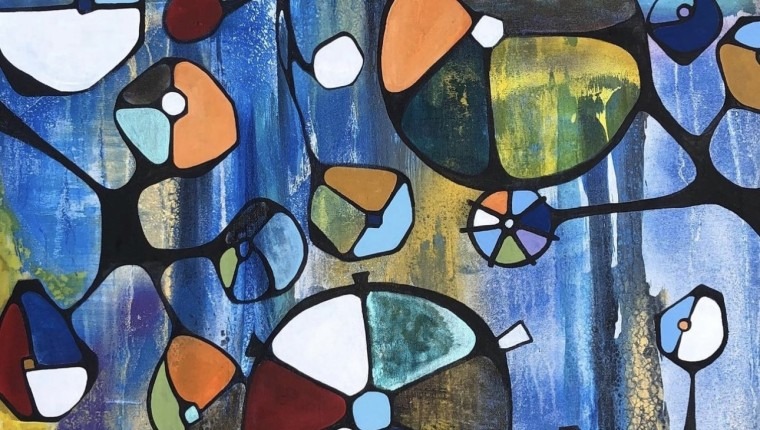By Antonio Permuy
. . .
Painter Embodies The Revival
of Florida’s Hispanic Heritage
. . .
Since the 2010s, the Tampa Bay arts community, led by the thriving scene in St. Petersburg and surrounding cities, has emerged as not only a dominant regional force, but increasingly one at the state level and beyond.
In that time, we have seen a slew of world-class, state-of-the-art museums emerge, led by the 2011 unveiling of the new Salvador Dalí Museum location in downtown St. Petersburg. We have also seen the launch of an annual SHINE Festival that has brought the local mural culture to international prominence, as well as growth of glass art that has flourished into a “Glass Coast” fueled by the likes of the Chihuly Collection, the Imagine Museum, and prominent gallery-studios like Duncan McClellan Gallery in St. Pete’s Warehouse Arts District.
As our arts scene continues to grow and evolve, it also continues to diversify. One interesting development is bringing the area’s future into connection with its past – the emergence of Hispanic and Latinx art.
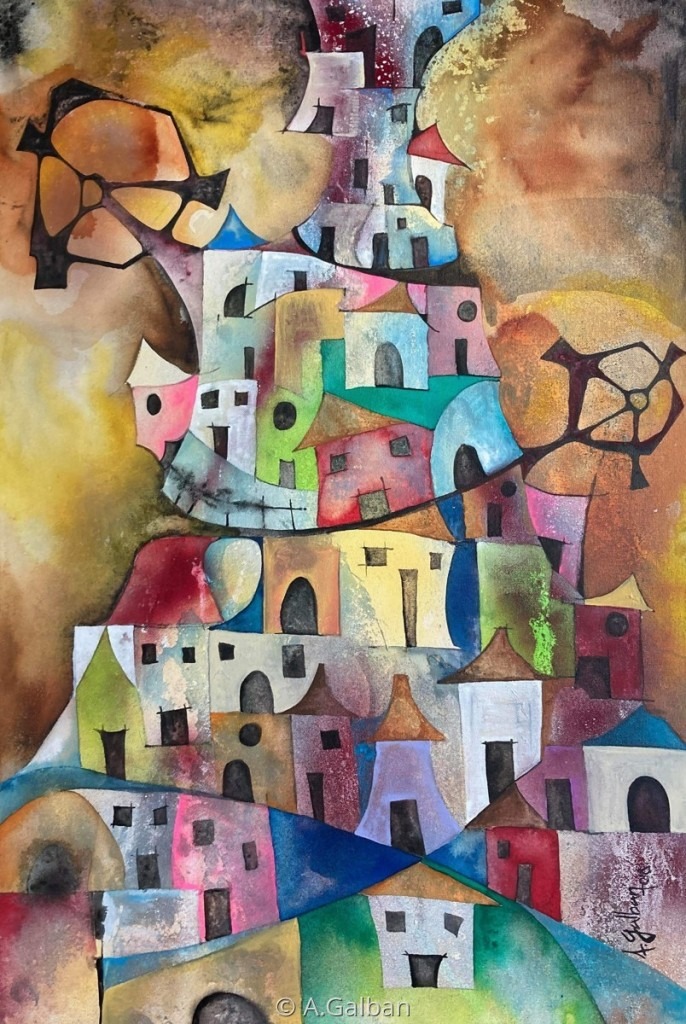
Before becoming part of the United States, Florida was (twice) a Spanish colony from the 16th to the early 19th centuries. This left an enduring mark on the culture and identity of Florida that can still be seen in cities like St. Augustine.
Our own Tampa Bay-based Gasparilla festival, named for the mythical Spanish pirate José Gaspar, is another nod to these roots. Having run for over a century, the festival has grown to include several offshoot events and one of the largest parades in the United States. This heritage is anchored prominently by the embrace of Spanish culture at the Dalí Museum in honor of its famous namesake.
These ties have been reinforced by our geography. Our closeness to other former Spanish colonies in Latin America, particularly the major commercial hub of Cuba, has kept a steady stream of Cuban trade and migration linking Florida with the legacies of Spanish culture. This is most evident with the enduring presence of a vibrant Cuban community in Tampa dating to the 1800s, which has since grown throughout the state, especially in Miami, since Fidel Castro’s Cuban Revolution of 1959.
Parallel to Pinellas County’s growth as an arts hub in the 21st century has been the slow but steady re-emergence of Cuban and Latinx culture as an increasingly visible component of this scene. One exponent of this growth — and a spearheading force of its future — is the artist Edel Alvarez Galban.
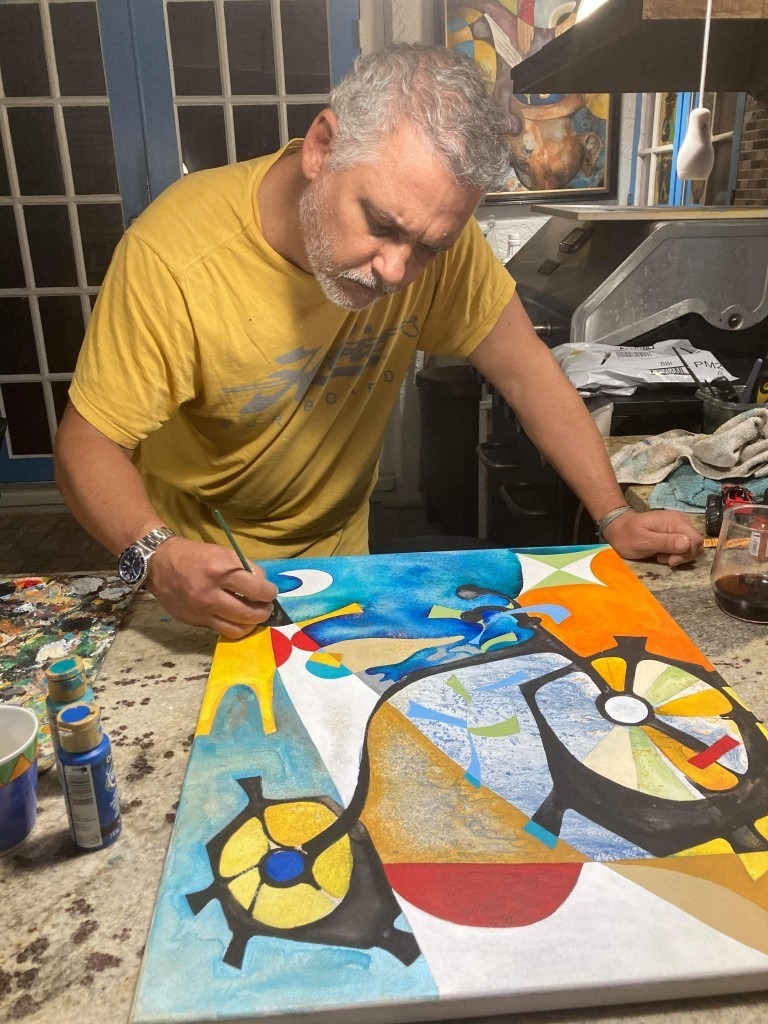
Born in Havana on September 28, 1967, he typically signs his works “A. Galban” or uses his alias “Lelo,” as he is better known informally. Galban embodies many of these unique cultural links and threads that Cuban culture has in Florida dating back to when travel was frequent between Cuba and Florida, particularly the South Florida and Tampa Bay areas. Retracing these historic routes, Galban himself is most active exhibiting his work in both these areas, although his work has also been featured in New York, Orlando and Puerto Rico.
Galban is an unconventional figure, even within the colorful Cuban exile art community. In addition to being an established Cuban American artist, he is also a medical doctor with a private practice in Clearwater. Walking into his office is a unique experience – you immediately feel as though you have crossed into a surreal fusion between a medical office and an art gallery.
Series of his painted works are on display in each room, including some of his larger-scale works that almost act as murals when the panels are aligned. All of this injects warmth and personality into what would otherwise be a standard clinical setting – relaxing patients physically while stimulating them creatively.
The space is essentially a glimpse into his inner world, bridging art with science in a surprisingly organic way.
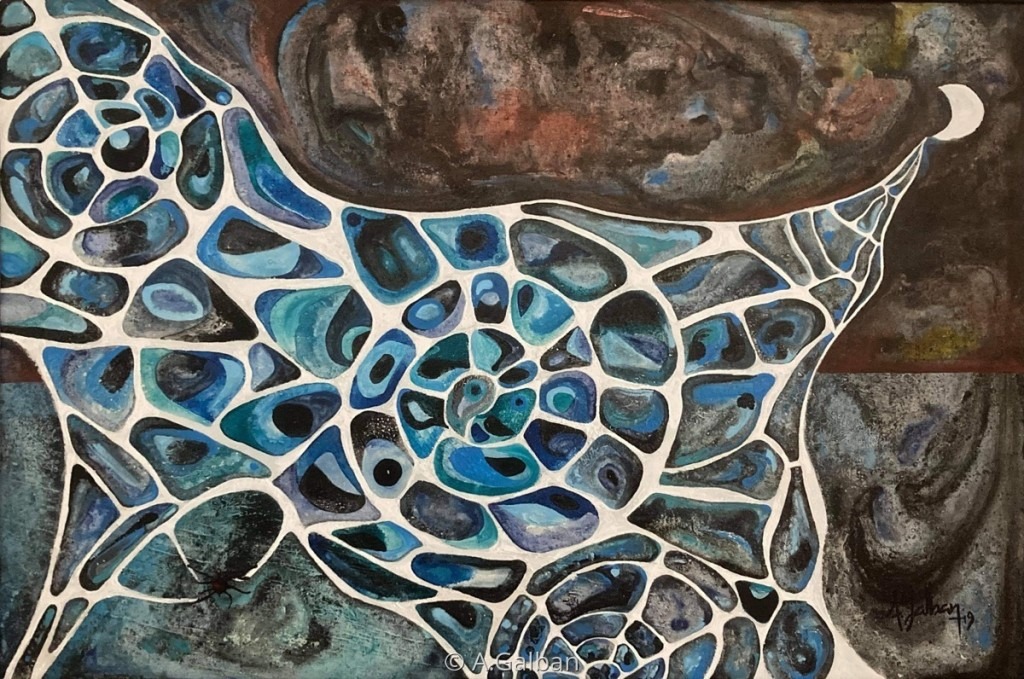
The arts have been in Dr. Alvarez Galban’s life from his earliest years in Cuba and he was frequently scolded as a child for painting during class. Galban did not formally pursue the arts until he was already well into adulthood. Instead, he opted for a more practical career path – medicine, his other passion. However, his trajectory changed in 1994 when he was unable to obtain permission from the Castro government to practice medicine. Galban used the roadblock as the impetus to finally start his art career that same year.
He began with sculpture before branching out and settling into painting and drawing. Painting, he felt, allowed him greater freedom, as well as a better medium to express his love of color.
After a year of studies, Galban emigrated to Miami in 1995 and wasted no time pursuing both his art and medical careers side-by-side. He soon became a board-certified physician in the US and also quickly joined Miami’s thriving scene of Cuban artists in exile. One of his earliest supporters was the respected and well-connected late Cuban artist Hortensia Gronlier (1933-2009), and widow of the poet José Alvarez Baragaño, who collected Galban’s work and introduced him to leading Cuban exile art figures, such as the pioneering Modernist painters Cundo Bermúdez and José Mijares.
In another interesting career twist, Galban is also a veteran of the Armed Forces. Two years after arriving in the United States, he enlisted to serve as a medic in the U.S. Army, which saw him apply his medical services in a range of new circumstances and settings. He served for three years, beginning in 1997, and at the end of his tenure continued to develop both his art and medical careers once again in a new country – Costa Rica. There he met Froilán Escobar, a highly-regarded Cuban writer and painter in exile with whom Galban would go on to collaborate.
Stylistically, Galban’s work draws from several significant cultural touchpoints – his vibrant Cuban-Caribbean upbringing, his current life in Florida, and significant European influences. He has been especially inspired by Spanish painters Joan Miró and Salvador Dalí as well as architect Antoni Gaudí, further reinforcing the historical Spanish links to our area through art. Galban has also traveled to Europe repeatedly and has been particularly inspired by his visits to Spain as well as France.
All of these influences converge to create a vivid and flowing cultural collage that breathes life into each of his works.

This has not gone unnoticed in the art world. His work has been exhibited alongside prominent Cuban artists, featured in books by renowned Latinx authors such as Léon Sánchez, and on the sets of popular Spanish language television programs. He has also participated in several high profile juried exhibitions in Tampa, Miami and Orlando, such as Nude Nite — the largest exhibition of nude art in the US. Galban was recently selected to create the poster for the 27th International Ballet Festival of Miami in 2022, which included a solo exhibition of his work entitled Visages de L’art.
A Pinellas local since 2001, Galban has been a pioneering exponent in the gradually growing Cuban art presence along Florida’s West Coast. In 2016 Cuban artist Michel Mirabal created a mural in St. Petersburg’s Warehouse Arts District. Located at 515 22nd Street South, the mural, titled New Era, boldly depicts the merging of the American and Cuban flags, representing the long-evolving relations between the two neighboring nations and their people.
Another significant development came two years later with the 2018 Ceaseless Stream collective exhibition in Lakeland, which spoke to this theme directly. The exhibition centered on five Cuban artists, including the prominent Cuban Neoexpressionist Adriano Nicot. The exhibition notably featured one of Nicot’s signature masterworks in the US – Donde el Alma se te Quiebra (Where the Soul Breaks).

The watershed show was spearheaded by Musaschy Filgueira of Lakeland, better known as “Niten,” and curated by Olga Chao. As reported by The Ledger, this exhibition was notable for being the first time Cuban artists organized an art show in Lakeland. Held in ART/ifact’s gallery at 820 N. Massachusetts Ave, Ceaseless Stream also featured works by Filgueira, Jesús Rivera, Antonio Guerrero, and even Argentina-based Juan Miranda.
Indeed, this emerging trend stretches south along Florida’s West Coast to Fort Myers. In recent years the city’s art scene has more frequently exhibited art from visiting Cuban artists, such as the DAAS CO-OP’s 2020 exhibition of Alex Lago’s work, and the Davis Art Center’s 2021 collective exhibition Encounter II.
More importantly, Fort Myers has a small but steady presence of full-time resident Cuban artists as well. One standout is Marlene Marrero whose multi-panel works like El Cubano/La Cubana and The Last Symphony bridge vibrant Cuban aesthetics with quasi-spiritual imagery to achieve both intimacy and dramatic flair within her paintings and mixed-media sculptures.
Against the backdrop of this expanding map, Galban is looking to make St. Petersburg a key cultural anchor for this growing movement in Hispanic art and help strategically position the area into a new hub — one with older Hispanic roots than even Miami has claim to.
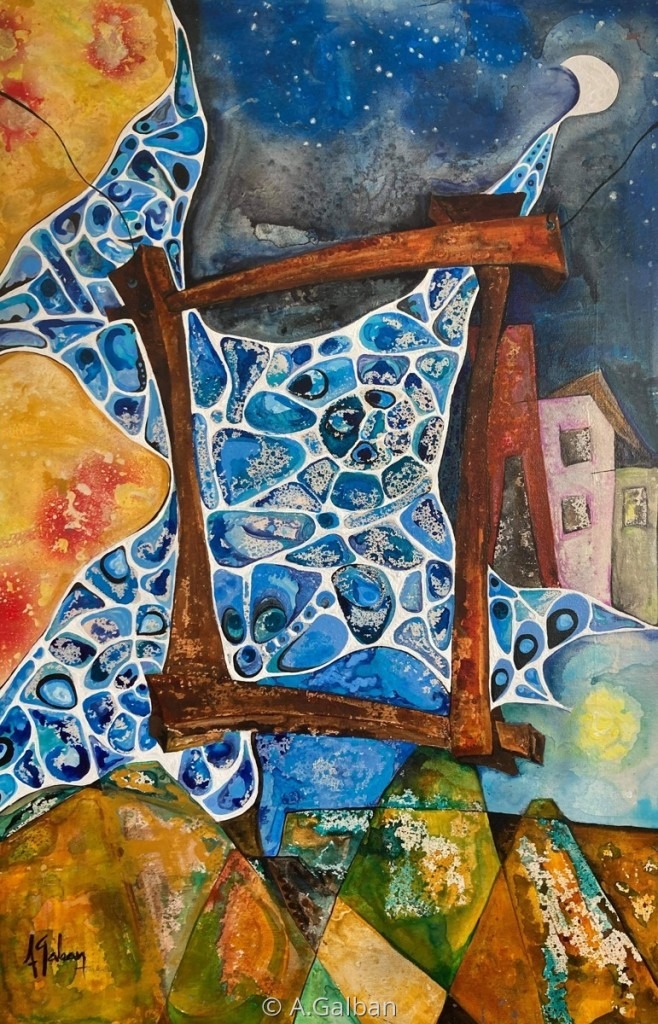
He is not alone – regional art institutions are taking close note. Just last year, the Tampa Museum of Art strengthened its ties to renowned Miami-based Cuban art collector, real estate developer and philanthropist Jorge Pérez. Mr. Pérez is the namesake of the Pérez Art Museum of Miami (PAMM), one of South Florida’s preeminent art institutions.
The Tampa Museum is currently showing the exhibit Time for Change: Art and Social Unrest in the Jorge M. Pérez Collection on view through August 23. Additionally, it was announced on November 17 of last year that Perez had donated the sculpture Mujer Vestida (Dressed Woman) by renowned Colombian artist Fernando Botero plus additional gift of $1 million to the museum.
Galban has ambitious plans of his own in the works to add another milestone contribution to this resurgence of Hispanic culture. He is currently organizing a group of Cuban artists to stage a major collective exhibition to showcase their work in a prominent regional venue. The artists selected will be predominantly from Galban’s generation, which emerged in the Cuban art scene during the 1980s and ‘90s.
This was a key period in Cuba’s artistic development that coincided with the emergence of Neoexpressionism internationally. As such, the exhibited works will be centered around a multilayered emphasis of impactful use of color, emotion and figurative abstraction to anchor their Cuban background into more universal themes.

Though the lineup is not finalized, two key figures, Nicot and Josignacio, have already signed on. Josignacio’s inclusion is noteworthy for his international reputation among the most commercially successful living Cuban artists. In 2016 his painting The Music is Timeless (1989) sold through London auction house McCarthy-Williams for nearly $3.5 million, setting a global record for highest auction price for a living Latin American artist, and making him the first living Latin American artist to sell an artwork for over $3 million.
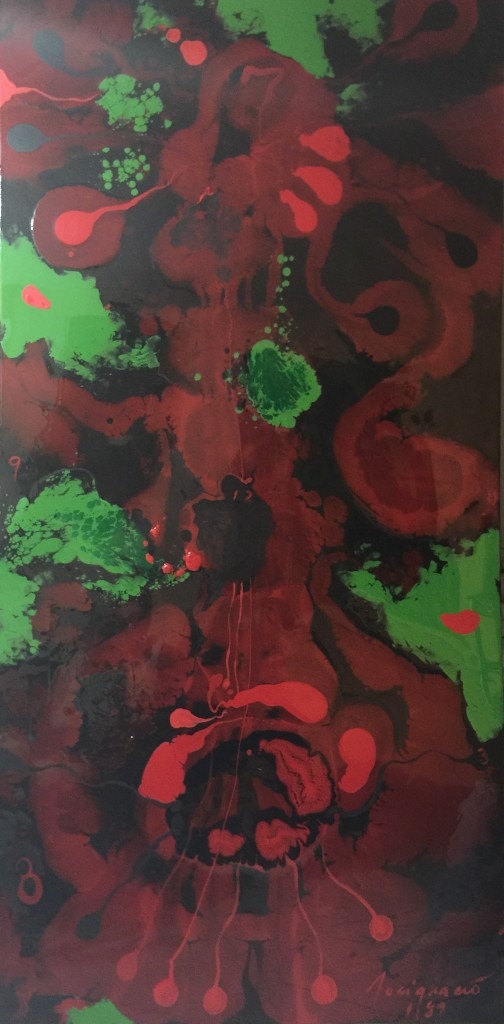
Like Nicot, he was mentored by the late Cuban master René Portocarrero. Josignacio first made a name for himself in Cuba during the 1980s when he developed his own medium of painting using melted plastic resin mixed with color pigment which he applied with a drip-poured technique. When he relocated to Miami, he became established in the US art market in the 1990s through Cuban art dealer Alfredo Martinez’s prominent Coral Gables-based galleries Marpad Gallery and Alfredo Martinez Gallery.
Galban is committed to this major exhibition being held in Tampa Bay by 2024, and hopes this showing will firmly cement the region’s unique position linking our local art scene with international art, in a way in keeping with our cultural roots and supportive of our art community.
. . .
